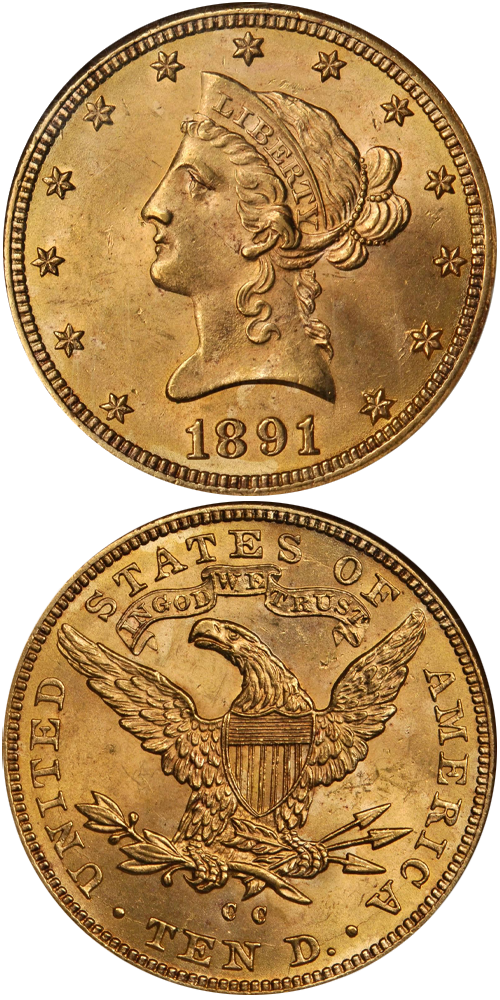1891-CC Liberty Head Eagle
Jeff Ambio: There are three different die marriages of the 1891-CC Liberty eagle known, each of which represents the pairing of different obverse and reverse dies. Winter 2-B has the date set low with the digits much closer to the denticles than the base of Liberty's portrait. The CC mintmark is basically level, with the first C over the left side of the letter N in TEN and the second C over the right side of the N. Magnification reveals several spindly stress die cracks on the reverse, contiguous through the letters in both the legend UNITED STATES OF AMERICA and the denomination TEN D.
Rusty Goe: The debate over equal rights for silver versus gold's sovereignty divided the political arena in the U.S. in 1891. The most ominous reports suggested that somehow the Treasury Department had opened a window that would allow Europe to raid the U.S.'s gold reserves.
European nations had already imported vast amounts of U.S. gold between 1888 and 1890. The Treasury Department had assured the public that the metal's movement across the Atlantic had subsided, but in February 1891 the outflow resumed, at an intensified pace.
England, the largest importer of U.S. gold, preferred double eagles and .999 fine bars. Apparently by early 1891, it had leaned heavily in favor of the bars. So much so that, upon the urging of Treasury Secretary Charles Foster, Congress amended an 1882 law that required the U.S. to pay gold bars upon demand, to instead allow the Treasury to assess a surcharge on such requests. However, even when required to pay a four percent premium, European governments continued to buy U.S. gold bars. Frustrated, Foster refused to issue any more bars after March, and ordered that if the foreigners wanted gold they would have to accept coins.
Though the Europeans would have preferred double eagles, Foster made sure that the subtreasuries filled orders with large quantities of the smaller gold denominations as well. Still, nothing could decelerate the expulsion of gold. The U.S. exported more of it in a six-month period in 1891 than it had in any 12-month period since the Civil War.
In May, Mint Director Edward O. Leech tried to assure the public that there was no cause for alarm in the large shipments of gold to Europe. The Los Angeles Herald of May 12, 1891, said Leech's words were reassuring only to people without brains.
If the run on the U.S. gold reserves in 1891 and the Treasury's attempt to curb it by issuing smaller denomination gold coins to European buyers, do not explain the Carson Mint's unprecedented turnout of half eagles and eagles, we are limited in our alternatives.
For whatever reason, 103,732 1891-CC eagles were struck; perhaps five percent of that number survives today. Colburn's superb workmanship, as well of that of the maker of the dies in Philadelphia, is seen on each one of the extant pieces.
Q. David Bowers: From the mintage of 1891-CC eagles, Rusty Goe estimates 4,100 to 5,000 exist, with 1,500 to 1,700 Uncirculated. My estimates are somewhat lower.
Most Mint State coins are MS-60 to MS-62, heavily bagmarked. All bets are off, however, when it comes to Gem Mint State! While many were repatriated in the late 20th century, the issue was readily available before that time, with a nod to Thomas L. Elder for saving so many scarce and rare gold coins from the melting pot. He alone in the mid-1930s sent circulars to banks stating for which dates and mints he would pay a premium. At the time members of the general public were turning in their gold coins in quantity in response to FDR's edict.
The example to the left was sold by Stack's Bowers Galleries in the August 2012 Battle Born Collection of Carson City Coinage, where it realized $58,750.






